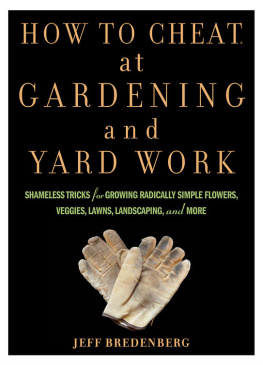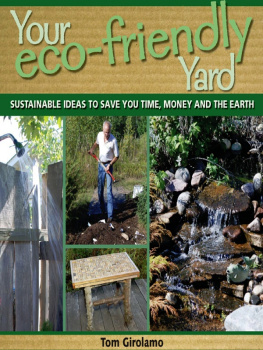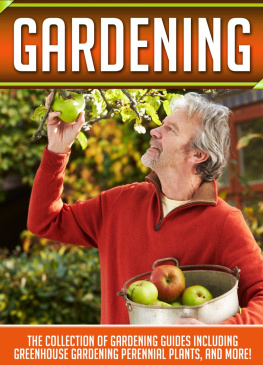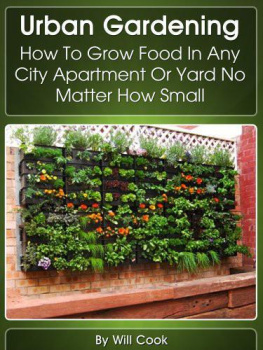One Incredible Tip, Alone Worth
the Price of This Book
The more we garden, the better we get at knowing what nature wants us to do.
G ARDEN COLUMNIST C HARLES F ENYVESI, IN HIS BOOK Trees
W ithin the first couple of pages here I am going to give you the full text of a tip that is so ingenious, so laborsaving, so cool, that for many people its easily worth the price of this book. How can I afford to do that? Gardeners are a caring, thoughtful bunch always ready to lend support, offer a helping hand, and pass along wisdom.
But first, heres a little background. I was talking on the phone the other day with Sam Jeffries, a horticulturist and radio personality. We were about to hang up when Sam dropped a bombshellone last gardening shortcut. (Yes, this one almost got away from me!)
Consider this scenario: A nursery truck has delivered to your front yard a young treea few hundred pounds of wood with burlap-wrapped rootball. You and your garden helpers have dug a planting hole in a carefully selected spot. Together, you wrestle that rootball into the hole. But here comes the quandary. You need to face the tree. That is, turn it until its best side is facing forward. This involves a combination of landscape design considerations, including an assessment of branch structure, open spaces, home architecture, surrounding vegetation, and sun exposure. You and your helpers again will have to awkwardly lift hundreds of pounds of wood and dirt, turning the trunk slowly until another person, directing the show, decides that the tree is facing the correct way. (And cover your ears if the director cant make up his or her mind.) Along the way, someone probably will snap off a branch or two in an effort to get a grip on the tree and turn it.
So heres Sams solution: Before you drop the tree into its planting hole, get your garden hose and fill the hole two-thirds of the way with water. A combination of buoyancy of the rootball and lubrication from the mud will make the tree easy to spin around in its planting hole, so you can quickly face the tree any way you wish. Also note that this technique gives the tree a nice start in its new home with a healthy drink of water.
Wow! I felt like I had just picked a gold coin up off the sidewalk. That tidbit has all of the elements of a superb tipits easily understood, it speaks to real people living their daily lives, there are no exotic materials involved, and there are no prissy rules to follow.
I hope you have a similar Wow! experience hundreds of times as you read this book. I have picked the brains of a horde of gardening and yard maintenance experts, identifying the clever little things they do when working in their own gardens and yards to save time, effort, money, and aggravation. I also asked them about their favorite tools and products and how they use them. (Speaking of products, I should say that its impossible to give specific advice without occasionally mentioning a brand name. When I mention a brand in this book, its because I believe in the productI dont accept any freebies from manufacturers.) And the products recommended in this book are organic, in keeping with Rodale tradition.
So pull on your garden gloves, slap on a broad-brimmed hat, and dive into How to Cheat at Gardening and Yard Work. Its jam-packed with ingenious shortcuts, tips, and tricks that are so sneaky that youll feel like youre cheating. At How to Cheat books, by the way, we use the word cheat in a benign sense. Theres nothing halfway, slipshod, or disreputable about the advice you will find here. And let me add that if any advice you encounter here makes you uneasy, fret notI dont want to be your guilty conscience. Just putter along to the next tip without another thought.
Now heres your invitation to join the How to Cheat movement. (Rallying cry: Simplicitywith Attitude.) Im sure that you have your own collection of clever tips and tricks, too. Feel free to share them by contacting me at www.howtocheatbooks.com or www.jeffbredenberg.com. Maybe Ill name you as a source in a future How to Cheat book!

The
CHEATING FRAME
of MIND

H ome gardening is the very definition of complexity. It boggles the mind when you sit down to calculate the possible combinations of plants, soil conditions, tools, personal tastes, geography, temperature, precipitation, and pests. Its enough to throw a gardener off his or her gourd. Well, How to Cheat enthusiasts carry a banner that reads, Simplicitywith Attitude. So for all of you who dare to take up hand pruners and step out the back door, your mind swimming with a zillion possibilities, heres a set of simplifying principles, gleaned from the host of experts I have encountered in my research. These observations will help you clarify, reduce, and focus as you garden. These ideas will put you in the right frame of mind to take serious shortcuts, to ignore the things that arent important, and to set your own prioritieswhich is to say: to cheat.
Other low-maintenance strategies, which youll come across in later chapters, are: Grow low-maintenance plants, be frugal, re-use and recycle, and ignore the conventional rules.
1. Gardening Has No End Point
Your garden is an ongoing, perpetually unfinished masterpiece. When you make mistakes, theres always a new season around the corner in which you can apply the lessons learned. This way, your garden gets better and better. Also, theres never a time when you smack the dirt off of your hands and proclaim, Finally, my garden is done!
2. It All Starts with the Earth
In just about every gardening pursuit, your success or failure hinges mightily on the quality of the soil that you are working with. This is called the POTS principle (Priority One: The Soil), so named because your author is addicted to shameless acronyms, as you will see.
3. Mother Nature Is More
Powerful Than You
As indicated in the quote on page x from the lyrical garden writer Charles Fenyvesi, nature is calling the shots in your garden. You would be well advised to employ the SAIL approach (Stand Aside, Interfere Little) when working with nature. Dont fight natural forces. Instead, use them to accomplish your goals.
4. Feel Free to Make
Mistakesand Learn
Get the best advice you can, try something, and learn from your mistakes. Gardening, like cooking, is not an exact science. Nevertheless, in the kitchen youre accustomed to precise ingredient lists and instructions for your recipes. But gardening is a hundred times more complex than that, with zillions of variables that will affect the success or failure of your garden. Such factors include climate, soil conditions, the materials you buy, the health of your plants, your maintenance habits, and even traditions (Grandma always did it this way.)
5. Take a Risk and Make
Gardening Fun
You got into gardening to express yourself, to learn new things, and to be amazed at what will grow and blossom. So by all means, make your outdoor passion fun. In the hundreds of decisions you will make every day, take some risks, experiment, try a little whimsy, go a little crazy, and do the unexpected.
6. Use Your Garden as a
Place of Therapy
Think of your garden as a therapeutic place, not a place of work. In the morning, take the newspaper out to your garden with an espresso. Sip, read, and contemplate. Stop and breathe deeply (and, yes, smell the roses). Later, after a stressful day of work, go out to the garden and pull some weedsit can be a calming and meditative experience. Breathe deeply and feel the sun on your face. Listen to the songs of birds. Sure, go ahead and talk to your plants. They wont answerwhich is therapeutic in a reaffirming way, because youre always right. When you do talk to your plants, your neighbors will stay far away from you, too. Let the garden become a place of comfort and renewal, and youll look forward to being there as often as possible.









